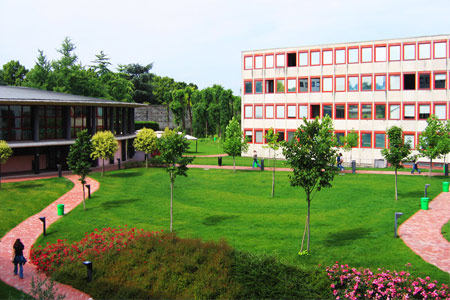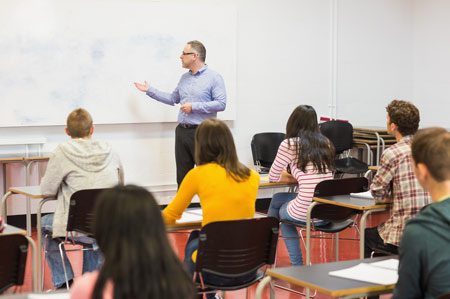Authors – Editors – Translators
The Case Study of Old Norse Vǫluspá (the ‘Seeress’s Prophecy’)
The course will deal with the rediscovery of ancient Nordic literary sources and how they impacted on the stylistic novelties in modern European literatures. The related vernacular texts, composed mainly in Iceland and secondary in Norway, from the 12th to the 15th centuries (a period which in the academic English nomenclature is referred to as ‘Old Norse’) had been spreading (from the end of the 17th century) through their earliest printed editions, which usually and inevitably were matched with their earliest translations (to begin with either Latin or modern Scandinavian language versions, followed by translations into the modern European languages of learning, English, German and French).
The rediscovery of those materials (often adapted to modern readers’ taste) strongly encouraged the remodeling of the contents, ideology and diction of poetry, from the romantic age onwards.
The topic will be surveyed on the case study of Old Norse Vǫluspá (the ‘Seeresse’s Prophecy’, whose oldest and principal manuscripts date from the 13th and 14th centuries) and on some of its earliest renderings into German and English, namely the translations by Herder (published within his collection of the ‘Volkslieder’, in 1779) and that of William Morris (composed in 1870 but unpublished up until May Morris’ edition of her father’s oeuvre, in the 30s of the 20th century). The pieces by Herder and Morris will be analytically compared with both what we now consider the movable ‘original’ text (with its different redactions transmitted by medieval handwritten witnesses) and the actual different ‘originals’ the German philosopher and the British poet had at their disposal.
The course will be divided into three main parts.
First part (= 5 weeks, = 20 hours)
Introduction to Old Norse Philology (Bibliography: 7 and 8), to the issues concerning text, subject and style of the Old Norse poem (Bibliography: 2, 4 and 11), and to more general aspects of the reception of Old Norse textual heritage into modern European literatures (Bibliography: 6, 9, 10)
Second part (= 2 weeks, = 8 hours)
The translation of the Voluspa within Herder's Volkslieder: structure, lexis, metre and style (Bibliography: 3)
Third part (= 2 weeks, = 8 hours)
The unpublished translation by William Morris: structure, lexis, metre and style (Bibliography: 1)
Bibliography
PRIMARY SOURCES
Manuscripts
1. British Library Add. Ms. 45, 318, ff. 32-41 (W. Morris’s autograph)
http://morrisedition.lib.uiowa.edu/Images/BL-45318/ProphecyValapageflip.html
2. Reykjavík, Stofnun Árna Magnússonar í íslenskum fræðum, GkS 2365 4to (the Codex Regius of the Poetic Edda)
http://www.germanicmythology.com/works/CODEXREGIUS.html
Edition and translations
3. Herder, Johann Gottfried, 1779. ‘Iduna, oder der Apfel der Verjüngung’, in Herder, Johann Gottfried von, Volkslieder nebst untermischten andern Stücke, Leipzig, Weygand: 183-195; repr. in Herders Sämtliche Werke, hg. von Bernhard Suphan, Berlin, Weidmannsche Buchhandlung, 1883, Bd. 18: 483-502
https://books.google.it/books?id=JZY6AAAAcAAJ&pg=PA197&lpg=PA197&dq=das+grab+der+prophetin&source=bl&ots=WlA-qEGGgW&sig=14vQo3WLiS7nx1MlEjxoqeNsdgE&hl=en&sa=X&ei=TVuDUOTrJOfoigLwtICQBA&redir_esc=y#v=onepage&q=das%20grab%20der%20prophetin&f=false (1779 edition, from Google books)
4. Meli, Marcello, a c. di, 2008. Vǫluspá. Un’apocalisse norrena, Roma, Carocci
5. Morris, William, 1870. The Prophecy of the Vala, in Morris, May, ed., 1938. William Morris Artist, Writer, Socialist, Oxford, B. Blackwell. 1st vol.: 543-63
http://www.germanicmythology.com/PoeticEdda/VSPMORRIS.html
LITERATURE
6. Clunies Ross, Margaret, and Lars Lönnroth, 1999. ‘The Norse Muse. Report from an International Research Project’, alvíssmál 9: 3–28
http://userpage.fu-berlin.de/~alvismal/9muse.pdf
7. Driscoll, Matthew J. 2010. ‘The words on the page: Thoughts on philology, old and new’, in Quinn, Judy and Emily Lethbridge, eds., Creating the medieval saga: Versions, variability, and editorial interpretations of Old Norse saga literature, Odense, University Press of Southern Denmark: 87-104
https://www.academia.edu/13048340/The_words_on_the_page_Thoughts_on_philology_old_and_new
8. Haugen, Odd Einar. 2007. ‘Textkritik und Textphilologie’, in Haugen, O. E. Ed. 2007. Altnordische Philologie. Norwegen und Island, Berlin, de Gruyter: 99-145
9. Larrington, Carolyne, 2007. ‘Translating the Poetic Edda’, in Clark, D., and C. Phelpstead, eds. Old Norse Made New, London, Viking Society: 21-42
http://www.germanicmythology.com/scholarship/LarringtonEdda.html
10. Malm, Mats. ‘Translations of Old Norse poetry and the lyric novelties of Romanticism’, in Quinn, Judy, and Maria Adele Cipolla. Eds. 2015. The Hyperborean Muse: Studies in the Transmission and Reception of Old Norse Literature, Turnhout, Brepols, Acta Scandinavica (forthcoming)
11. Quinn, Judy, ‘The Principles of Textual Criticism and the Interpretation of Old Norse Texts Derived from Oral Tradition’, in Quinn, Judy, and Maria Adele Cipolla. Eds. 2015. The Hyperborean Muse: Studies in the Transmission and Reception of Old Norse Literature, Turnhout, Brepols, Acta Scandinavica (forthcoming)







